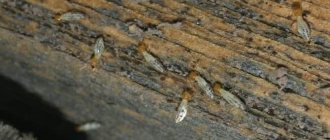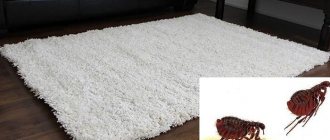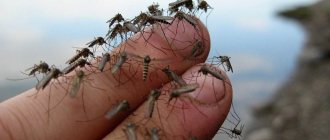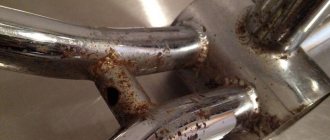27.11.2019
Sometimes in the bathroom you can see small silvery insects that scatter in different directions in the light. These are silverfish or, as they are popularly called, silverfish. Usually they are rarely paid attention to because they do not bite, do not carry infections and seem to do absolutely no harm to humans. However, once you encounter these unpleasant neighbors, it immediately becomes clear that you need to get rid of them immediately!
- What kind of insect is this?
- How dangerous is silverfish for humans?
- Where do insects live?
- Traditional methods of fighting silverfish
- Chemicals against silverfish
- Prevention of pest occurrence
What kind of insect is this?
Silverfish belongs to those types of insects that lived many years ago, in the Paleozoic era. True, then representatives of this species preferred to live in damp forests, choosing damp moss or thickets of ferns as housing. Over time, they moved to people's homes and other premises suitable for their residence and reproduction.
Appearance
Silverfish belong to the bristletail order. This is evidenced by their tail, at the end of which there are three processes, one of them directed back, and two to the sides. The silver or silver-brown color of the body is no more than 2 cm in length. It has a teardrop shape - a wide head and a tapering tail. There is a pair of antennae on the head. After several molts, the body of adult individuals becomes covered with scales, which is how the insect got its name.
Common silverfish
Life cycle
The silverfish is an insect with an incomplete metamorphosis cycle, that is, there is no pupal stage. They reproduce quite slowly: at a temperature of 18-20 degrees, the cycle of transformation from an egg into an adult can take several months, but at a temperature of 37 degrees or more, the development time is very shortened and is about 11-12 weeks. If the room is heated, then development lasts about a year, and if it is cold, then the cycle can last three years. That is, if a couple of individuals appear in the apartment, they will not be able to fill the entire room. For the normal development of a colony, a minimum of 10 individuals is required, and this process will take a lot of time.
The first stage of silverfish development is the egg. One clutch can contain more than 60 eggs. The oval-shaped eggs reach a length of only 1 mm. Newly laid eggs are white and turn brown as they mature. At temperatures above 30 degrees, ripening takes a little more than three weeks, but when the temperature drops even to 20 degrees, the ripening process becomes much longer - up to 10 weeks.
Silverfish nymph
After the eggs mature, white larvae hatch. They still have no scales at all. In total, the larvae survive 5 molts. With each subsequent molt, they become larger in size and acquire more and more scales.
After the fifth moult, the larvae become adults capable of reproduction. Usually, as they mature, the larvae gradually change color from white to silver, but this does not always happen; some adults remain white. From time to time, adults also go through a molting stage.
Lifestyle Features
It is believed that these insects originated from tropical forests, so silverfish prefer a warm and humid microclimate. Ideal conditions for reproduction and habitat are air temperature of 25-30 degrees and humidity of more than 80%. Therefore, the most common place for them to live in an apartment is the bathroom or kitchen. Silverfish do not like light, so they get out of their hiding place mainly at night, therefore, when you turn on the light in the bathroom at night, you can see how the insects rush in all directions. They move surprisingly quickly, which sometimes scares people.
Silverfish
Pests feed mainly on food of plant origin, which contains starch or polysaccharides - flour, sugar, book binding, glue, paper, fabrics containing starch. However, they do not have to live in close proximity to a food source. They can settle in a neighboring room, with a microclimate more suitable for living, crawling out at night in search of food. At the same time, adults can live up to 300 days without food. And at temperatures below 10 degrees they go into suspended animation.
Types of silverfish
There are many species of silverfish in the world, both wild ones that live in nature and domestic ones that live indoors. There are two types common in houses:
- common or sugar silverfish;
- home thermobia.
They differ from each other in color and size. Thermobia is brown in color and slightly smaller in size - up to 15 mm. Silverfish are larger - up to 2 cm. Thermobia loves high temperatures, so it is more often found in the kitchen than in the bathroom.
Home thermobia
How dangerous is silverfish for humans?
It's hard to believe, but the pest does not pose any danger to humans. It does not bite and does not carry dangerous infections. Therefore, some people do not wonder how to get rid of it as effectively and quickly as possible. However, despite the fact that silverfish seem quite harmless, they can cause significant damage to property. In addition, the appearance of these individuals is quite unpleasant. Therefore, having seen such unpleasant neighbors, it is better not to let the situation take its course, but to take measures to destroy them.
In the kitchen, they can spoil food, leaving residues of their vital activity - skins after molting and excrement - in cereals, flour and sugar. Eating such foods is not only unpleasant and unhygienic, but also dangerous to health. The waste products of the pest in large quantities can cause allergies or poisoning.
The feeding habits of silverfish, namely their love for polysaccharides and starch-containing products, lead to the fact that interior items or wallpaper can become a source of nutrition for small insects, as a result of which they leave traces of their presence in household items - holes in things, excrement, and sometimes lay eggs .
Books, magazines, photographs, and sometimes paintings are also attacked by silverfish. Rare or collectible photographs, books, or art may be damaged. Therefore, in archives or museums where the level of humidity in the room is disturbed, silverfish are one of the most hated enemies.
Linen or things made of starched fabric can also attract unwanted guests, because there is so much tasty and satisfying food here.
Silverfish also appear in warehouses - grocery, construction, industrial, but they will not be able to damage a large number of things in the warehouse, but such warehouses can become a source of infection of houses and apartments.
Recommendations for disinfection in the apartment
It is recommended to react to the appearance of uninvited guests immediately, without expecting mass spread. Both chemicals and folk remedies are suitable for killing insects in a room/apartment.
You need to start processing after following a number of recommendations:
- It is first recommended to do a wet cleaning of the apartment , thoroughly wash all secluded places using cleaning liquids with the addition of chlorine. Wait until the treated surfaces dry.
- Remove children and pets from the premises and cover the aquariums with film.
- Prepare special clothing , a respirator and rubber gloves for your own safety.
- Pack all products in airtight bags or seal them in jars.
- Move all objects away from their intended habitats, clear out the corners.
- Spray the poisonous agent in all corners and surfaces.
- Close the windows and doors of the room for 1 hour.
- After time has passed, ventilate.
- Do not carry out wet cleaning for 1 week, then disinfect again.
- After waiting a week after re-treatment , wash all surfaces again and place objects in their places.
Read more ► How to get rid of double-east quickly: the best folk and special remedies, methods of prevention
Where do insects live?
Silverfish can be found in places where favorable conditions have been created for their habitat and reproduction. Most often these are the kitchen and bathroom, namely:
- near water and sewer pipes;
- near sinks and bathtubs;
- in bulk products in the kitchen;
- in places where garbage is stored;
- near the refrigerator;
- near the sink in the kitchen.
Favorable living conditions are created by temperature (20 degrees or more), humidity (more than 70%) and nearby food sources. However, do not think that nasty tenants live only in the kitchen and bathroom. If all conditions are met, they can easily live on the balcony or in the room.
The main reasons for the spread of the pest are the appearance of contaminated things or products in the house, unsanitary conditions, and the presence of individuals in neighboring apartments, from where they can enter your home through the ventilation.
Traditional methods of fighting silverfish
Traditional recipes, as a rule, are less effective compared to insecticides, but are perfect for those who do not want or for various reasons cannot use chemistry. Let's look at the most common methods of fighting using traditional methods.
- Tobacco, red pepper and baking soda. You need to take 3 grams of each substance, dilute these powders in 1 liter of water and spray them in insect habitats. After 8 hours, you need to wipe the areas where the solution was sprayed with water and bleach.
Red pepper
- Spices. Silverfish cannot stand the smell of cloves and cinnamon. You can place cinnamon sticks or clove seeds in bookcases and wardrobes. Spices such as bay leaf, garlic and sage also work well.
- Alum. 10 g of alum is dissolved in 0.5 liters of boiling water, then sprayed in pest habitats. If necessary, the procedure must be repeated several times.
- Citrus zest. Orange and lemon zest are great for repelling unwanted residents. It needs to be laid out throughout the apartment, paying special attention to closets with clothes and books, and changed about once a week.
Citrus zest
- Cedar shavings. Silverfish really do not like the smell of cedar shavings, so they can also be used in pest control. The shavings are also laid out on shelves in closets and throughout all rooms in the apartment, paying attention to places where the colony accumulates.
- Lavender. Lavender essential oil is usually used, which is diluted in water and sprayed indoors. This method will also help repel many other unpleasant insects in the house, such as moths.
Lavender
- Fresh cucumbers. The cucumber should be cut into slices and placed in the habitats of the silverfish. The smell of fresh cucumber is unpleasant for insects, so they will quickly leave their habitable place.
- Boric acid. It helps to get rid of more than just silverfish. Boric acid powder is poured into the pest's habitat. After a week, you need to clean, remove the powder, and after cleaning, add it again. In another week, clean again. This way you will destroy both the adults and the larvae that have just hatched from the eggs.
Traps
There are two types of traps that can help catch pests.
Take a glass jar, wrap the outside with electrical tape, and put a piece of sugar or starch inside. Insects will run into the jar at night to taste the treats, but will not be able to get back out along the smooth walls of the jar.
Take a newspaper, roll it into a roll, secure the roll with an elastic band. Then the newspaper should be moistened with water and left. By morning, silver coins will come running towards the newspaper, and then the newspaper must be destroyed, for example, burned.
Chemicals against silverfish
Modern insecticides are quite effective against various types of insects. Serebryanka is no exception. If you have decided to use chemicals, then pests have infested the entire house. There are many different types of drugs, differing in method of application, active substance, etc. However, not all drugs can be quite effective in the fight against silverfish. This is due to the fact that the necessary trials of such drugs are often not carried out.
Of all insecticides, dusts are the most effective. But it is worth monitoring the humidity in the room - dust clumped from moisture does not attract silverfish. Dusts such as Chisty Dom, Ripan, and Fenaksin are often purchased.
Sprays and aerosols also have a strong effect. Among the products that are used against silverfish, it is better to choose products that contain pyretoids and pyretin. The most popular sprays are Combat Superspray, Dichlorvos, and Clean House.
There are chemical concentrates that have proven to be excellent in pest control. These are Get, Tetrix, Cucaracha, Lambda Zone, Delta Zone.
Less effective, but still used in everyday life, are crayons and gels. The structure of the body allows the poison to penetrate inside, so such products can also help. Absolute, Cleanbait, Fas, Raptor gels are used.
Sticky traps. Since silverfish reproduce slowly, this method can significantly reduce the pest population. They use Domovoy, Global, and Argus traps.
Adviсe
By implementing a set of measures, it will be easier to achieve complete extermination of silverfish. If there are very few insects, several methods may be sufficient.
Repeat the measures a month later to destroy young individuals that have just hatched from eggs.
Plant-based aerosol products will be ineffective in the fight.
To disinfect at home, you must purchase one of the following products:
- A bathtub cleaner that contains chlorine.
- Copper sulfate.
- Special aerosols for killing insects.
Sources
- https://notklop.ru/nasekomye/ostorozhno-cheshuynitsa-v-vannoy-kak-izbavitsya-chto-delat-i-kak-vyvesti-top-5-sredstv/
- https://combat-dez.ru/prichiny-poiavleniia-cheshyinicy-v-kvartire-i-metody-borby-s-nei/
- https://master-dez.ru/dezinsektsiya/nasekomye/cheshuynitsa/
- https://ubirahka.ru/pests-in-the-house/%D1%87%D0%B5%D1%88%D1%83%D0%B9%D0%BD%D0%B8%D1%86%D1 %8B-%D0%B2-%D0%BA%D0%B2%D0%B0%D1%80%D1%82%D0%B8%D1%80%D0%B5-4-%D1%81%D0% B0%D0%BC%D1%8B%D1%85-%D1%8D%D1%84%D1%84%D0%B5%D0%BA%D1%82%D0%B8%D0%B2%D0%BD /
- https://GdeKlop.ru/other/cheshujnitsa-v-kvartire/
- https://vreditelstop.ru/cheshuynica/prichiny-poyavleniya-cheshuynicy.html
- https://vivoz-gbo.ru/tualet/v-kvartire/sredstva-ot-cheshujnic
- https://volgograd.sesuslugi.ru/info/cheshuynicy/98-kak-izbavitsya-ot-cheshuynic-v-domashnih-usloviyah.html
- https://severdv.ru/sovety/pochemu-v-vannoj-zavelis-nasekomye-i-chto-pri-etom-delat/
- https://legkovmeste.ru/poleznye-sovety/kak-izbavitsya-ot-cheshuynits-v-zhilyih-pomeshheniyah-s-pomoshhyu-narodnyih-metodov-i-sredstv-promyishlennogo-proizvodstva.html
- https://septik.guru/kanalizaciya/cheshuynitsyi-v-kvartire-kak-izbavitsya.html
- https://FB.ru/article/282109/beloe-nasekomoe-v-vannoy-cheshuynitsa-mokritsa-prichinyi-poyavleniya-i-metodyi-borbyi
- https://KlopSOS.ru/nasekomye/kak-izbavitsya-ot-cheshujnicy-v-kvartire/
- https://hozzi.ru/uborka/mokritsy-v-kvartire-kak-izbavitsya
- https://apest.ru/nasekomye/cheshujnitsa/
- https://severdv.ru/sovety/kak-pravilno-izbavlyatsya-ot-cheshujnicz-v-kvartire/
- https://katuna.ru/cheshujnica-kak-izbavitsya
[collapse]
Prevention of pest occurrence
To prevent the appearance of silverfish, it is enough to follow simple steps.
- Avoid high levels of humidity in the premises. Particular attention should be paid to the bathroom and kitchen. If possible, dry the room using fans or heated towel rails.
- In a timely manner, seal cracks and cracks in the walls, which can become a haven for a colony.
- Ventilate the rooms in the apartment, open a window or vent more often. In winter, prolonged ventilation also creates unfavorable temperature conditions, because... Pests do not tolerate low temperatures well.
- Clean the apartment regularly, prevent the accumulation of dirt and debris, periodically clean with bleach dissolved in water.
- Deprive the pest of its food source. Do not leave food on tables that can attract various insects, not just silverfish.
- Observe the storage conditions for clothes and books, and avoid high humidity in closets. If there are things that you do not wear, it is better to store them in plastic vacuum bags.
As you can see, in most cases, the fight against silverfish ends in success, and having gotten rid of the pest, it is not so difficult to carry out prevention so as not to encounter unwanted neighbors again.
How to properly treat a room?
Proper cleaning of the premises is the key to successfully getting rid of insects. It is necessary to remove all remaining debris and seal cracks and holes, otherwise the parasites will return again. After thorough cleaning, you can begin treating floors and all surfaces. Whatever preparations you decide to use, they must be applied to places where insects accumulate, floors, remote corners and ventilation niches.
Insecticides can be removed from surfaces only after 48 hours. Home remedies take longer to work, so remove them later. Before treating the premises, you can collect insects with traps and Velcro for several days.
If silverfish attack an apartment building, independent control of parasites may be ineffective, since the insects will move from one apartment to another. In this case, you should contact a professional pest control service. Comprehensive measures will not only get rid of insects, but will also protect against repeated invasion for a long time.
Features of disinfection in the bathroom
Cleaning and disinfection in the bathroom should be carried out according to the following plan:
- Elimination of excess. Hygiene products are placed in a basin, a rug and towels are placed in the wash, and the curtain is soaked in a soapy solution.
- Washing tiles. Apply the detergent using a sponge to the dampened surface of the walls. An anti-mold spray can be used to clean tile joints.
- Pipe cleaning. A thick pipe cleaning gel is poured into the drain holes to remove dirt and blockages.
- Cleaning the toilet and bathtub. The cleaning agent is applied to the surface of the bathtub for a while and then washed off. Water is removed from the toilet, then the lid, walls and surface under the rim are washed. For disinfection, the product is left on the surface and then removed.
- Cleaning mirrors. Wash with detergent and wipe with a soft cloth.
- Washing the floor. The floor is washed with a disinfectant, then rinsed with clean water and wiped.
Note! For cleaning, you must choose products without abrasives.
Very often we just clean the bathroom, but forget about disinfection.











